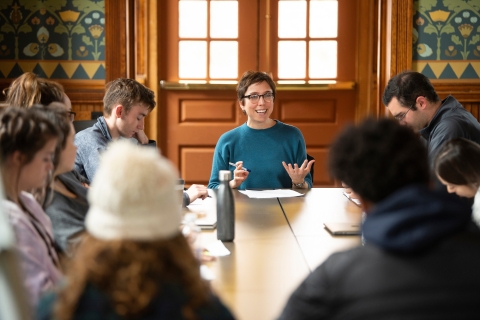Cool Classes: Dying for God: Martyrs and Monks
June 30, 2016
What class? Dying for God: Martyrs and Monks
Who teaches it? Professor John Penniman, religious studies
"I think most students assume that the history of a religion — especially a religion set within the ancient world — is going to be dull. One of the goals of this course is to show that, for early Christians, the world was as enchanted a place as we find in our great contemporary myths like Harry Potter or Lord of the Rings or Star Wars.
"One unique aspect of this course is that, in addition to those primary source readings, I also use a text called Martyrdom: The Coloring Book. Created by Hallie Fryd and Julie Gfrörer, the coloring book depicts the deaths of 50 different saints, often in gruesome detail. Each episode includes a brief account of the saint's life as well as how they continue to be revered in Christian memory.
"Students will read about a martyr who was so pure her skin could not be pierced by the executioner's sword, a monk who gets lost in the desert and is rescued by a centaur, and another monk who gets so annoyed with people asking him for spiritual advice that he decides to live atop a tall pillar for nearly 40 years. By encountering these eccentric lives, I suspect students will be surprised by the blending of history and legend and myth in the formation of religious identities. But more than that, I think students will be surprised that these stories — no matter how fantastic or unbelievable — continue to have purchase in modern Christianity.
"In moving between the coloring book and the ancient sources, I hope students begin to see how sainthood is a form of collective memory. Saints are made by those who get to tell the story, long after the person in question has died. The way these stories were retold over centuries reveals something crucial about the values and aspirations that Christians have wanted to emphasize. By reading and coloring the stories of the martyrs, students are able to reflect more critically on the ways in which the body, gender, pain and death have been powerful tools for crafting an argument about what it means to be a 'true' Christian.
"I love the idea of a coloring book about martyrdom because it demonstrates how history — especially the history of a religion — is always open to interpretation and reinterpretation. A coloring book reminds us that we, as readers, interact with stories as we read. Indeed, generations of readers have helped to shape how these ancient stories are understood. Even now, readers draw their own meaning out of them. And by coloring, students are forced to make interpretive decisions in a very tactile way.
"I'm willing to bet that this is first time most students have had a coloring book as a required text — much less a coloring book with a body count. But my hope is that this way of engaging ancient sources will actually pull the students deeper and deeper into the rabbit hole of early Christianity."
Are we missing out on a cool class? Send suggestions to coolclasses@bucknell.edu.

Photo by Emily Paine, Communications
Explore Your Curiosity in the Humanities
Religious studies is one of nearly 50 majors in Bucknell's College of Arts & Sciences. Not sure which is for you? You have until sophomore year to decide. Start exploring by applying to Bucknell.

